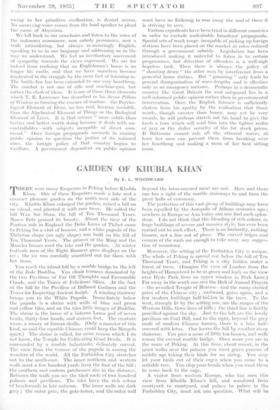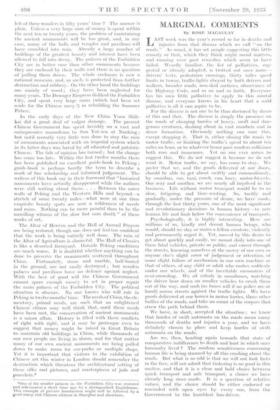GARDEN OF KHUBLA KHAN
By B. L. WOODWARD
THERE were many Emperors in Peking before Khubla Khan. One of these Emperors made a lake and a summer pleasure garden on the north-west side of the city, Khubla Khan enlarged the garden, raised a hill on an island, and planted it with rare trees. He called the hill Wan Sui Shan, the hill of Ten Thousand Years. Marco Polo praised its beauty. About the time of the Puritan rule in England the Dalai Lama of Thibet came to Peking for a visit of honour, and a white pagoda of the Thibetan shape (an ugly shape) was built on the hill of Ten Thousand Years. The princes of the Ming and the Manchu houses used the lake and the garden. At winter festivals men of the Eight Banners gave displays on the _ice ; the ice was carefully smoothed out for them with .hot irons.
' . You reach the island-hill by a marble bridge to the left of the Jade Buddha. You climb terraces dominated by the two Pavilions of Far Off Thoughts and Favourable Clouds, and the Tower of Felicitous Skies. At the foot of the . hill lie the Pavilion of Diffused Coolness and the Tower for Inspecting Ancient Script. A winding stairway brings you to the White Pagoda. Immediately below the pagoda is a shrine with walls of blue and green rind yellow tiles, and on the tiles little images of Buddha. The shrine is the home of a hideous Lama god of seven heads, thirty-four hands, and sixteen feet. The creature .wears a rosary of huMan skulls. (Only a monster of this kind, so said the equable Chinese, could keep the Mongols quiet.) The shrine is called, for some reason which I do not know, the Temple for Cultivating Good Deeds. It is surrounded by a marble balustrade, delicately carved. The view from the terrace of the pagoda is among the wonders of the world.. All the Forbidden City stretches out to the south-east. The inner northern and western walls meet a few hundred yards from the foot of the, hill ; the southern and eastern gatehouses rise in the distance. Between the walls you see the tiled roofs of two hundred palaces and pavilions. The tiles have the rich -colour of beeehwoods in late autumn. The inner walls are dark grey ; the outer gate, the gate-tower, and the outer wall beyond the lotus-covered moat are red. Here and there one has a sight of the marble stairways to and from the great halls of ceremony.
The perfection of this vast group of buildings may have been equalled by the Acropolis of Athens centuries ago ; nowhere in Europe or Asia today can one find such splen- dour. I do not think that this blending of rich colour, in large buildings of severe and massive style, has ever been carried out to such effect. .There is no barbarity, nothing bizarre, not a line out of place. The curved ridges and corners of the roofs are enough to take away any sugges- tion of monotony.
Moreover, the setting of the Forbidden City is unique. The whole of Peking is spread out below the hill of Ten ThOusand Years, and Peking is a city hidden under a - forest of trees. (Imagine the view of London from the heights of Hampstead to be as green and leafy as the view over Hyde Park from an upper window in Park Lane.) Far away in the south one sees the Hall of Annual Prayers —the so-called Temple of Heaven—and the many-storied gates of the Chinese city ; .eastward, gates again, and a few modern buildings half-hidden in the trees. To the west, strongly lit by the setting sun, are the ranges of the Western Hills, three lines of hills ; the third line is faintly pencilled against the sky. Just to the left are the lovely pavilions on Coal Hill, and to the right, beyond the grey roofs of modern Chinese houses, there is a lake half- covered with lotus. One leaves the hill by another steep staircase. You pass a score of little tea-houses, and walk across the curved marble bridge. Once more you are in the maze of Peking. At this time, about sunset, in the quiet walks near the palaces you meet grave persons of middle age taking their birds for an airing. You may let your birds out of their cages when you come to a suitable tree. You clap your hands when you want them to come back to the cage.
A visitor from western Europe, who has seen this view from Khubla Khan's hill, and wandered from courtyard to courtyard, and palace to palace in the Forbidden City, must ask one question. What will be left of these wonders in fifty years' time ? The answer is plain. Unless a very large sum of money is spent within the next ten or twenty years, the problem of maintaining the ancient monuments will be too great, and, in any ease, many of the halls and temples and pavilions will have crumbled into ruin. Already a large number of • buildings of the greatest beauty and interest have been :allowed to fall into decay. The palaces of the Forbidden City are in better case than other monuments because they are enclosed by their walls and there is no question of pulling them down. The whole enclosure is now a national museum, and, as such, is protected from further destruction and robbery. On the other hand the buildings are mainly of wood ; they have been neglected for :many years. The Dowager Empress disliked the Forbidden City, and spent very large sums (which had been set • aside for the Chinese navy !) in rebuilding, the Summer Palace. In • the early days of the New China Yuan Shill- • kai did 'a great .deal of vulgar damage. The present Chinese Government has spent lavishly on a vast and unimpressive mausoleum to Sun Yat-sen at Nanking ; but until recently very little was done to stay the ruin • of monuments associated with an imperial system which in its latter days'avas hated by all educated and patriotic Chinese. The tide of opinion has turned ; but the change has come too late. Within the last twelve months there has been published an excellent guide-book to Peking ; guide-book is perhaps hardly the term to .describe a work of fine scholarship and informed judgement. The writers of this book say in their foreword that "historical monuments have actually disappeared while the authors were still writing about them. . . . Between the outer walls of Peking and the Western Hills and beyond—a stretch of some twenty miles—what were at one time exquisite beauty spots arc now a wilderness of weeds and ruins. Nothing can be more painful than to be the unwilling witness of the slow but sure death " of these 'works of art.
• The Altar of Heaven and 'the Hall of Annual Prayers arc being restored, though one does not feel too confident that the work is being entirely well done. The ruin of the Altar of Agriculture is shameful. The Hall of Classics is like a- deserted farmyard: Outside Peking conditions are much worse. It is doubtful whether anything can be done to preserve the monuments scattered throughout China. Fortunately, stone and marble, half-buried in the ground, are not easily destroyed ; but wooden palaces and pavilions have no defence against neglect. With the best of good will the Chinese Government `cannot spare enough money to set in proper repair the main palaces of the Forbidden City. The political situation is obscure. No one knows who will rule in Peking in twelve months' time. The needs of China, the ele- mentary, primal needs, are such that an enlightened Chinese citizen may well think that, until these needs have been met, the conservation of ancient monuments is a minor affair. History is filled with these conflicts of right with right, and it may be grotesque even to suggest that money might be raised in Great Britain to maintain old buildings in China, while thousands of our own people are living in slums, and for that matter many of our own ancient monuments are being pulled down to make room for car-parks or multiple shops. Yet it is important that visitors to the exhibition Of Chinese art this winter in London should remember the destruction which threatens the architectural setting of these silks and pictures, and masterpieces of jade and porcelain.* *One of the smaller palaces in. the Forbidden City. was rostoreci and redecorated a short time ago by a distinguished Englishman. This example of private benefaction might well bo followed by a good many rich Chinese citizens in Shanghai and elsewhere.













































 Previous page
Previous page